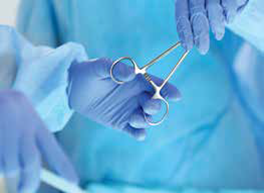
If you are having hernia surgery, chances are you have encountered the term “mesh” in discussions with your physician. Hernias occur when part of your intestine or abdominal fat bulges through a hole in the abdominal wall. To repair a hernia, surgeons often use a special type of sterile woven mesh (typically made from polypropylene or an alternative synthetic material) to either fill the hole or act as a barrier so the tissue can no longer push through the abdominal wall. As the body heals, your own tissue will grow over and around the mesh.
Mesh (sometimes called a patch) has been used in 99% of hernia repairs performed in the United States over the past 30 years, and is considered both safe and effective. This doesn’t mean there aren’t ever complications from hernia surgery, but surgeries using mesh and those that don’t have similar complication rates. The most common issue experienced by patients with mesh repairs is a sensation of “feeling” the mesh after certain types of hernia surgeries (different surgeons use different techniques), along with pain and discomfort in the days after surgery.
Enlisting our help before surgery can make a significant difference in your recovery from hernia mesh repair. Because the surgery involves cutting fascia and moving muscles in the abdomen, your core inevitably will sustain some trauma. You need to build strength and correct any dysfunction the surgery may have caused. Not only will this help prevent future problems such as nerve entrapment or chronic pain but it may also improve your body’s ability to heal.
We can design a physical therapy program that helps you strengthen your core, maintain flexibility and increase stability without compromising your recovery. Think of the mesh aspect of your hernia repair as the safety net and physical therapy exercise as responsible for holding up that net. With the help of both, you’ll be back on your feet in no time.
